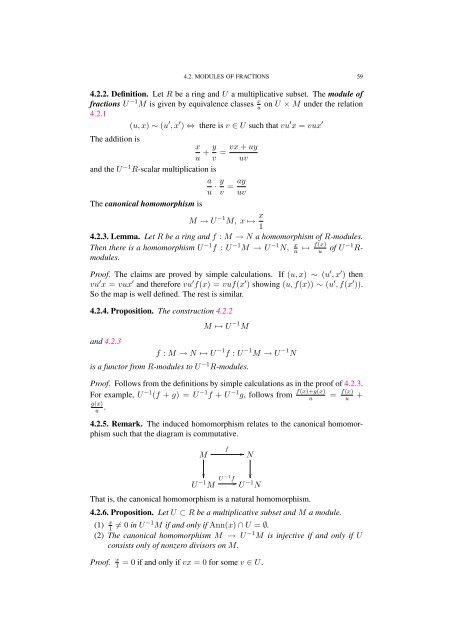Commutative algebra - Department of Mathematical Sciences - old ...
Commutative algebra - Department of Mathematical Sciences - old ...
Commutative algebra - Department of Mathematical Sciences - old ...
Create successful ePaper yourself
Turn your PDF publications into a flip-book with our unique Google optimized e-Paper software.
4.2. MODULES OF FRACTIONS 59<br />
4.2.2. Definition. Let R be a ring and U a multiplicative subset. The module <strong>of</strong><br />
fractions U −1M is given by equivalence classes x<br />
u on U × M under the relation<br />
4.2.1<br />
(u, x) ∼ (u ′ , x ′ ) ⇔ there is v ∈ U such that vu ′ x = vux ′<br />
The addition is<br />
x y<br />
+<br />
u v<br />
and the U −1R-scalar multiplication is<br />
a y<br />
·<br />
u v<br />
The canonical homomorphism is<br />
= vx + uy<br />
uv<br />
= ay<br />
uv<br />
M → U −1 M, x ↦→ x<br />
1<br />
4.2.3. Lemma. Let R be a ring and f : M → N a homomorphism <strong>of</strong> R-modules.<br />
Then there is a homomorphism U −1f : U −1M → U −1N, x f(x)<br />
u ↦→ u <strong>of</strong> U −1R modules.<br />
Pro<strong>of</strong>. The claims are proved by simple calculations. If (u, x) ∼ (u ′ , x ′ ) then<br />
vu ′ x = vux ′ and therefore vu ′ f(x) = vuf(x ′ ) showing (u, f(x)) ∼ (u ′ , f(x ′ )).<br />
So the map is well defined. The rest is similar.<br />
4.2.4. Proposition. The construction 4.2.2<br />
and 4.2.3<br />
M ↦→ U −1 M<br />
f : M → N ↦→ U −1 f : U −1 M → U −1 N<br />
is a functor from R-modules to U −1 R-modules.<br />
Pro<strong>of</strong>. Follows from the definitions by simple calculations as in the pro<strong>of</strong> <strong>of</strong> 4.2.3.<br />
For example, U −1 (f + g) = U −1f + U −1g, follows from f(x)+g(x)<br />
u<br />
g(x)<br />
u .<br />
= f(x)<br />
u +<br />
4.2.5. Remark. The induced homomorphism relates to the canonical homomorphism<br />
such that the diagram is commutative.<br />
M<br />
f<br />
<br />
N<br />
<br />
<br />
U −1M U −1f <br />
U −1N That is, the canonical homomorphism is a natural homomorphism.<br />
4.2.6. Proposition. Let U ⊂ R be a multiplicative subset and M a module.<br />
(1) x<br />
1 = 0 in U −1M if and only if Ann(x) ∩ U = ∅.<br />
(2) The canonical homomorphism M → U −1M is injective if and only if U<br />
consists only <strong>of</strong> nonzero divisors on M.<br />
Pro<strong>of</strong>. x<br />
1 = 0 if and only if vx = 0 for some v ∈ U.
















